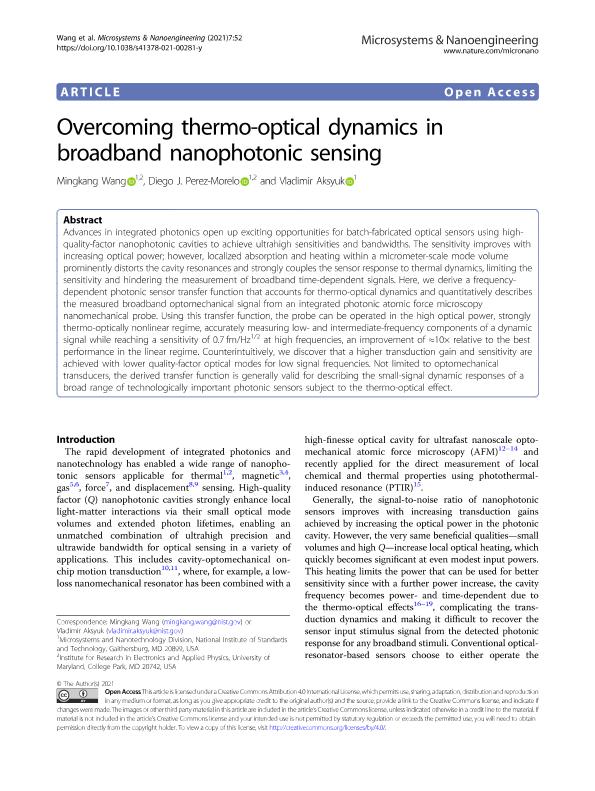Artículo
Overcoming thermo-optical dynamics in broadband nanophotonic sensing
Fecha de publicación:
12/2021
Editorial:
Nature Publishing Group
Revista:
Microsystems and Nanoengineering
e-ISSN:
2055-7434
Idioma:
Inglés
Tipo de recurso:
Artículo publicado
Clasificación temática:
Resumen
Advances in integrated photonics open up exciting opportunities for batch-fabricated optical sensors using high-quality-factor nanophotonic cavities to achieve ultrahigh sensitivities and bandwidths. The sensitivity improves with increasing optical power; however, localized absorption and heating within a micrometer-scale mode volume prominently distorts the cavity resonances and strongly couples the sensor response to thermal dynamics, limiting the sensitivity and hindering the measurement of broadband time-dependent signals. Here, we derive a frequency-dependent photonic sensor transfer function that accounts for thermo-optical dynamics and quantitatively describes the measured broadband optomechanical signal from an integrated photonic atomic force microscopy nanomechanical probe. Using this transfer function, the probe can be operated in the high optical power, strongly thermo-optically nonlinear regime, accurately measuring low- and intermediate-frequency components of a dynamic signal while reaching a sensitivity of 0.7 fm/Hz1/2 at high frequencies, an improvement of ≈10× relative to the best performance in the linear regime. Counterintuitively, we discover that a higher transduction gain and sensitivity are achieved with lower quality-factor optical modes for low signal frequencies. Not limited to optomechanical transducers, the derived transfer function is generally valid for describing the small-signal dynamic responses of a broad range of technologically important photonic sensors subject to the thermo-optical effect.
Palabras clave:
Photonics sensor
,
MEMS
,
Transfer function
,
Thermo-optical effect
Archivos asociados
Licencia
Identificadores
Colecciones
Articulos (UE-INN - NODO BARILOCHE)
Articulos de UNIDAD EJECUTORA INSTITUTO DE NANOCIENCIA Y NANOTECNOLOGIA - NODO BARILOCHE
Articulos de UNIDAD EJECUTORA INSTITUTO DE NANOCIENCIA Y NANOTECNOLOGIA - NODO BARILOCHE
Citación
Wang, Mingkang; Perez, Diego Javier; Aksyuk, Vladimir; Overcoming thermo-optical dynamics in broadband nanophotonic sensing; Nature Publishing Group; Microsystems and Nanoengineering; 7; 1; 12-2021; 1-11
Compartir
Altmétricas




